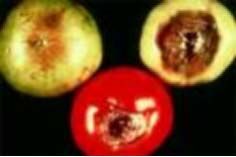What is fruit rot?
Fruit rot is a disease which is usually associated with ripening of fruit.
Causal Organism: Alternaria spp, Phoma spp., Colletotrichum spp., Trichothecium spp, Cladosporium spp.
Symptoms –
Phoma fruit rot – The disease appears on the ripening fruit. The infected fruits remain small and develop slightly depressed, dark brown spots near the stem ends. The lesions become irregular in shape and measure 15-25 mm in diameter.
Alternaria fruit rot – Slightly depressed, brown to dark brown, circular lesions appear on the fruit. Sometimes concentric rings are also present on these spots. The smaller spots coalesce to form larger spots.
Colletotrichum fruit rot – The disease appears at the start of ripening of the fruit in the form of small, slightly depressed, light brown, water-soaked lesions. These spots coalesce and enlarge. Under humid conditions, the acervuli are formed in masses on these spots.
Trichothecium fruit rot – The disease is observed during the spring in the form of pink spots on the fruits. The fungus can survive in the soil for a long time. Fruits touching the soil may become infected and develop symptoms.
Cladosporium fruit rot – The disease appears near the time of fruit ripening. Injured fruits become infected. The symptoms of the disease start from the tip of the fruit forming.

Mode of spread –
Phoma fruit rot
- The fungus survives in plant debris, the primary source of infection.
Alternaria fruit rot
- The fungus survives in debris and soil.
- The fruits touching the soil become infected and the disease spreads later by dissemination of spores through the air.
Colletotrichum fruit rot
- Being saprophytic the pathogen survives in soil, along with the debris, for a long period. This becomes the primary source of infection.
- The spores are present in the air and act as secondary sources of infection and are disseminated by rain splashes.
Cladosporium fruit rot
- It is also spread by spores present in the air.
- The fungal spores survive in plant debris and soil, the primary sources of infection
Management:
| Cultural Practices | Chemical Control |
| Using the disease-free planting material.Follow drip irrigation because it confines the dispersal of the pathogen.Remove infected leaves, weeds, and twigs from the orchard and destroy it. | Foliar spray of –Copper Oxychloride 50% WP @ 2 gm/litre.Hexaconazole 2% SC @ 1.5ml/litre.Mancozeb 75% WP @2 gm/litre. |
Reference –








